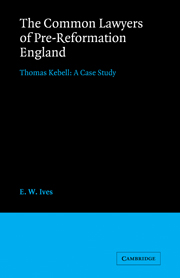Book contents
- Frontmatter
- Contents
- List of figures and tables
- Preface
- Abbreviations
- Manuscript sources
- Table of cases
- Introduction
- PART I THE LEGAL PROFESSION
- PART II LEGAL PRACTICE
- PART III THE LAWYERS AND THE LAW
- PART IV THE PROFESSION AND SOCIETY
- Appendices
- A The will of Thomas Kebell
- B The inventory of Thomas Kebell
- C List of pleaders c. 1518
- D Serjeants-at-law created 1463 to 1510
- E Senior members of the legal profession, 1461–1510
- Index
E - Senior members of the legal profession, 1461–1510
Published online by Cambridge University Press: 05 November 2011
- Frontmatter
- Contents
- List of figures and tables
- Preface
- Abbreviations
- Manuscript sources
- Table of cases
- Introduction
- PART I THE LEGAL PROFESSION
- PART II LEGAL PRACTICE
- PART III THE LAWYERS AND THE LAW
- PART IV THE PROFESSION AND SOCIETY
- Appendices
- A The will of Thomas Kebell
- B The inventory of Thomas Kebell
- C List of pleaders c. 1518
- D Serjeants-at-law created 1463 to 1510
- E Senior members of the legal profession, 1461–1510
- Index
Summary
The following tables show the changes in the personnel of the upper ranks of the common-law profession for the period 1461 to 1510, year by year. All judges, barons of the exchequer, king's Serjeants, Serjeants and law officers are listed in order of seniority, with dates of appointment, death etc.; the seniority of Serjeants is normally that of the close roll.
Names printed in roman type are of men in post on 1 Jan. of each year; additions in the year are given in italic type. Reappointments on the change of monarch are placed in square brackets.
The principal source for appointments is the patent roll. This has been augmented by the record of payments from the exchequer which were charged, by statute, on a variety of accountants– the clerk of the hanaper, the customers of London (generally, though not always, the customers of the petty custom), the customers of Bristol and Hull and the merchant staplers of Calais. Material is principally located in PRO classes E159 (K.R. Memoranda Rolls), E356 (Customs Accounts), E364 (Foreign Accounts: Pipe Office) and E405 (Tellers' Rolls), but not in EIOI (Accounts Various: Hanaper). I am indebted to Miss Margaret Condon for help in tracing this material. For some of the later information I have followed the work of Dr J.H. Baker, whose tables list the senior members of the profession from (usually) 1485 to at least 1547, and also include schedules of court officers for the fifteenth and sixteenth centuries: Spelman, Reports, ii. 351–96.
- Type
- Chapter
- Information
- The Common Lawyers of Pre-Reformation EnglandThomas Kebell: A Case Study, pp. 481 - 510Publisher: Cambridge University PressPrint publication year: 1983



